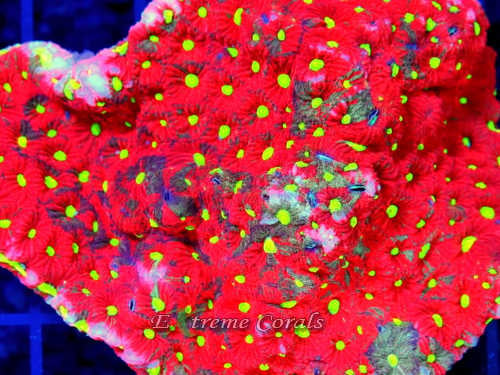Extreme Corals News and Updates
How to care for Favites Coral in a Reef Tank
Find out how to properly care for your new Favites coral with this "how-to" guide on the requirements for healthy Favites coral from the #1 place to buy corals online!
Read along to find out the Lighting, Water Flow, Feeding, Placement & more when it comes to the care of your new Favites
by scott Shiles • March 01, 2023
Favites coral (LPS), also known as moon coral, is a popular and easy-to-care-for coral species that can add vibrant colors and interesting textures to a reef tank. However, like all coral species, Favites requires proper care and attention to thrive in a captive environment. In this blog post, we'll explore some tips and best practices for caring for Favites coral in your reef tank.
Provide Adequate Lighting
Favites coral requires moderate to high lighting to thrive. Ensure that your reef tank has the appropriate lighting intensity and spectrum to support the coral's photosynthesis needs. LED lights are a popular choice among reef tank enthusiasts as they can be customized to provide the right spectrum and intensity of light for coral growth.
Maintain Stable Water Parameters
Stable water parameters are essential for the health of Favites coral. Maintain stable pH, temperature, salinity, and alkalinity levels within the recommended range for your reef tank. Use a reliable test kit to monitor these parameters regularly, and make adjustments as needed.
Provide Adequate Water Flow
Favites coral requires moderate water flow to help it remove waste and debris from its surface. Ensure that your reef tank has adequate water circulation, either through the use of powerheads or other circulation pumps. Be careful not to direct the flow directly onto the coral, as this can cause tissue damage.
Regular Water Changes
Regular water changes are essential for the health of your Favites coral. They help to remove accumulated waste and maintain stable water parameters. Aim to change around 10% of your reef tank's water volume every two weeks.
Feed Regularly
Favites coral is a mixotroph, which means it can derive nutrition from both photosynthesis and feeding. Although it can survive on photosynthesis alone, feeding the coral with small pieces of meaty foods such as mysis shrimp or zooplankton can help promote growth and enhance its coloration. Feed the coral once or twice a week, depending on its appetite.
Avoid Overcrowding
Favites coral requires enough space to spread out its polyps and feed properly. Ensure that you don't overcrowd your reef tank with too many coral species, as this can lead to competition for resources and space. Leave enough room between coral colonies to allow for growth and expansion.
Monitor for Signs of Disease
Favites coral is susceptible to diseases, just like any other coral species. Keep an eye out for any signs of tissue recession, discoloration, or unusual behavior. If you notice any of these signs, isolate the affected coral and seek advice from an experienced reef tank expert.
Additional Information
Favites corals are known for their aggressive nature. These corals possess long sweeper tentacles that have the capability to extend and sting nearby corals. It is crucial to provide ample personal space for the growth and well-being of Favites corals, in order for them to thrive undisturbed.
Favites corals are predominantly found in the wild across the expansive Indo-Pacific region. Their natural habitat spans from the Red Sea to the Indian Ocean, extending further into the Western Pacific Ocean reaching as far as Japan, the Line Islands, and the Tuamotu Islands. These stony corals, belonging to the Merulinidae family, establish their presence in diverse marine environments throughout this extensive geographic range.
The price range for favites corals can vary depending on factors such as the specific coloration and size of the specimen. These characteristics ultimately determine the cost associated with the coral.
Aquacultured specimens are meticulously handled and grown, keeping in mind the needs and preferences of reef enthusiasts. The focus is on providing a seamless transition into home aquariums. These specimens undergo a careful nurturing process, from growth to propagation, ensuring their optimal development and health. The utmost care is taken throughout, guaranteeing that the specimens are nurtured using industry best practices. This approach ensures that the aquacultured specimens are well-prepared for their new environment, facilitating a smooth acclimatization process in home aquariums.
In conclusion, caring for Favites coral in a reef tank requires attention to lighting, water parameters, water flow, feeding, and disease prevention. By providing a suitable environment and regular care, you can enjoy the beauty of this coral species for years to come.

